INSTALLATION
MANUAL
SPLIT UNIT AIR CONDITIONER
INDOOR UNIT
RAK-DH24PCAST
OUTDOOR UNIT
RAC-DH24PCAST
EN INSTRUCTION MANUAL
FOR SERVICE
PERSONNEL ONLY
Home
Screw for Mounting Plate
(4.1x32)
THE CHOICE OF MOUNTING SITE
(Please note the following matters and obtain permission from customer before installation).
WARNING
●
The unit should be mounted at stable, non-vibratory location
which can provide full support to the unit.
WARNING
●
The outdoor unit must be mounted at a location which can support
heavy weight. Otherwise, noise and vibration will increase.
CAUTION
●
No nearby heat source and no obstruction near the air outlet is
allowed.
●
The clearance distances from top, right and left are specifi ed in
fi gure below.
●
The location must be convenient for water drainage and pipe
connection with the Outdoor unit.
●
To avoid interference from noise please place the unit and its
remote controller at least 1m from the radio, television and inverter
type fl uorescent lamp.
●
To avoid any error in signal transmission from the remote controller,
please put the controller far away from high-frequency machines
and high-power wireless systems.
●
The installation height of indoor unit must be 2.3m or more.
CAUTION
●
Selecting the installation location: Suitable location that will reduce the
impact from rain and direct sun that may affect the unit performance.
Besides that, ventillation must be good and clear of obstruction.
●
The air blown out of the unit should not point directly to animals or plants.
●
The clearances of the unit from top, left, right and front are specifi ed in
fi gure below. At least three of the above sides must be open air.
●
Be sure that the hot air blown out of the unit and noise do not disturb
the neighbourhood.
●
Do not install at a location where there is fl ammable gas, steam, oil and
smoke.
●
The location must be convenient for water drainage.
●
Place the outdoor unit and its connection wire at least 1m away from the
antenna or signal line of television, radio or telephone. This is to avoid
noise interference.
●
Do not install outdoor unit facing strong wind direction. It may damage
the fan motor.
●
Do not install the outdoor unit in a place where small animals may build
their nests. If small animal goes inside the unit and touches the electrical
parts, failure of the unit, smoke or fi re may be caused. Request your
customer to keep the surrounding of the unit is clean.
INDOOR UNIT
Names of Indoor Components
Direction of Piping
OUTDOOR UNIT
Be sure to
completely
seal any
gap with
putty.
There are 6 directions
allowed, namely, horizontally
perpendicular to the unit,
vertically down from right,
horizontally out from right,
horizontally out to left,
horizontally out to right,
vertically down from left.
<
IA2184: B
>
Screw for holder of
Remote Controller
(3.1x16)
AAA Size Battery
Mounting Plate
Qty
No.
Component’s Name
1
6
1
2
2
Remote Controller
Dimension of Mounting Stand
of the outdoor unit
(unit : mm)
1
2
3
4
5
6
1
Installation of Hanger, Wall Penetration and Installation of Protection Pipe
1
CAUTION
●
The draining of the water container inside the indoor unit can be done from the left.
Therefore the mounting plate must be fi xed horizontally or slightly tilted towards the
side of drain hose. Otherwise, condensed water may overfl ow the water container.
Direct Mounting On The Wall
●
Please use hidden beams in the wall to hold the mounting plate.
Wall Penetration and Installation of Protection Pipe
●
Drill a ø 65mm hole on
wall which is slightly tilted
towards the outdoor side.
Drill the wall at a small
angle.
●
Cut the protection pipe
according to the wall
thickness.
●
Empty gap in the sleeve
of protection pipe should
be completely sealed with
putty to avoid dripping of
rain water into the room.
●
Connect the connecting cord after removing electrical
cover. (Refer to “CONNECTION OF POWER CORD”)
●
After adjustment, fi t the connecting cord and pipes into
the space available under the indoor unit.
●
The rubber strap used for fi xing the insulator should
not be tied with great force. Otherwise, this will damage
heat insulation and causes water condensation.
THE CONNECTION OF REFRIGERATING PIPE DURING THE
INSTALLATION OF INDOOR UNIT
Preparation To Install Refrigerating Pipes
CAUTION
●
Please fi x in the plastic core
after fl aring to avoid copper
chips entering the pipes.
CAUTION
You are free to choose the side (left or right) for the installation of drain hose.
Please ensure the smooth fl ow of condensed water of the Indoor unit during
installation. (Carelessness may result in water leakage.)
CAUTION
Be sure that the
drain hose is not
loosely connected
or bend.
Be sure that the wire is not
in contact with any metal
in the wall. Please use
the protection pipe as wire
passing through the hollow
part of the wall so as to
prevent the possibility of
damaged by mouse.
Unless it seals completely,
any air with high humidity
flows from outdoor and
dew may drop.
WARNING
●
The end of the refrigerating pipes are at locations
marked with “
” symbol.
Installation of Drain Hose
3
Installation
Hang the Indoor unit onto the mounting plate. Use the temporary stand at
the back of the Indoor unit to push its lower part 15cm forwards.
●
Place the drain hose through the hole on the wall.
●
Wrap the refrigerating pipes with insulation pipe after connecting refrigerating
pipe.
●
Connect the connecting cord after removing electrical cover. (Refer to
“Connection of Power Cord”)
●
After adjustment, the connecting cord and refrigerating pipes are placed
into the space available under the Indoor unit.
●
The projection of Indoor unit must hook to the mounting plate.
INDOOR UNIT
Pipe
Connecting cord
Drain hose
Binding band
Insulation pipe (must
be wrapped with vinyl
tape at every 120 mm)
Binding band can be
installed to whichever
side of the installation
recommended to attach
it on the right side
viewing from the rear.
points. However, it is
1100 mm
Protection
pipe
Connecting cord
Connected
Bottom
cover
section
Drain hose
Claw
Indoor unit notch
Procedures of Installation and Precautions
●
Procedures to fi x the mounting plate.
1. Drill holes on wall. 2. Push plug into the holes. 3. Fix the mounting plate on wall
(As shown below) (As shown below) with 4.1 x 32 screw
(As shown in fi gure below)
●
Procedures to fi x the holder of remote control.
1. Drill holes on wall. 2. Push plug into the holes.
(As shown below) (As shown below)
The connection of insulated
drain hose.
Please use insulated drain
hose for the indoor piping
(commercial product).
The indoor piping
should be insulated
with the enclosed
insulation pipe.
(If the insulator is
insuffi cient, please
use commercial
products).
Installation of the Indoor Unit
2
VERTICALLY DOWNWARD PIPING
Preparation
● Connect connecting cord.
● Pull out the pipe, connecting cord and drain
hose.
Installation
● The upper part of the indoor unit is hanged on the mounting plate.
● The projection at the lower part of the indoor unit is hooked onto the mounting plate.
Please pull the lower
part of the indoor unit
outwards to check if
the unit is hooked onto
the mounting plate.
Improper installation
may cause vibration
and noise.
!
CAUTION
Condensed water may leak out if not
inserted properly.
Figure showing the Installation of Indoor and Outdoor Unit.
Above
100mm
CAUTION
●
Do not guide the drain hose to places where corrosive gases (sulfur, ammonia, etc.) are generated,
such as septic tanks and sewer.
Corrosive gas may fl ow backward from the drain hose to the indoor unit, corrode the copper pipe, or
it may cause offensive odors in the room.
●
Cut the drain hose at a position 100 mm higher than the fl oor surface. It may cause water leakage
due to air lock or clogging of foreign matter.
CAUTION
●
A brazed, welded or mechanical
connection shall be made before
opening the valves to permit
refrigerant to fl ow between the
refrigerating system parts. A vacuum
valve shall be provided to evacuate
the interconnecting pipe and/or any
uncharged refrigerating system.
●
Mechanical connectors used indoor
shall comply with ISO 14903.
When mechanical connectors are
reused indoors, sealing parts shall
be renewed. When fl are joints are
reused indoors, the fl are part shall
be re-frabricated.
●
Refrigerant tubing shall be protected
or enclosed to avoid damage.
●
Flare connection only at
outside of building
WARNING
●
Installation of pipe length less than
minimum pipe length requirement
(3 meters) may generate an
abnormal sound.
CAUTION
!
Refrigerant piping
must be protected
from physical
damage. Install a
plastic cover or
equivalent.
In case the pipe length is more than the recommended length for chargeless,
add refrigerant R32 as below. Do not exceed the maximum pipe length.
CAUTION
!
7
2
Purifying Filter
SAFETY PRECAUTION
●
Read the safety precautions carefully before operating the unit.
●
The contents of this section are vital to ensure safety. Please pay special attention to the following sign.
WARNING ........ Incorrect methods of installation may cause death or serious injury.
CAUTION ......... Improper installation may result in serious consequence.
Be sure that the unit operates in proper condition after installation. Explain to customer the proper way of operating
the unit as described in the user’s guide.
Tools Needed For Installation Work
●
Flare nut must use a torque wrench without fail. Tighten with the specifi ed tightening torque.
If the fl are nut is tightened too much, after a long period of time, the fl are nut breaks, Gas
leakage, stagnation, touching fi re, rarely cause ignition.
●
Sharp bending of the pipe use the polyethylene rod, bend not crushed the pipe. Gas leakage
from the crushed part, stagnation, touching fi re, rarely cause ignition.
●
Please request your sales agent or qualifi ed technician to install your unit. Water leakage,
short circuit or fi re may occur if you do the installation work yourself.
●
Please observe the instructions stated in the installation manual during the process of
installation. Improper installation may cause water leakage, electric shock and fi re.
●
Make sure that the units are mounted at locations which are able to provide full support to
the weight of the units. If not, the units may collapse and impose danger.
● Must install air conditioner according to the electrical installation standards for Thailand of
the Engineering Institue of Thailand under The Royal Patronage of His Majesty (the King).
●
Be sure to use the specifi ed wire for connecting the indoor and outdoor units. Please ensure
that the connections are tight after the conductors of the wire are inserted into the terminals.
Improper insertion and loose contact may cause over-heating and fi re.
●
Please use the specifi ed components for installation work. Otherwise, the units may collapse
or water leakage, electric shock and fi re may occur.
●
Be sure to use the specifi ed piping set for R32. Otherwise, this may result in broken copper
pipes or faults.
●
When installing or removing an air conditioner, only specifi ed refrigerant (R32) shall be
allowed, do not allow air or moisture to remain in the refrigeration cycle. Otherwise, pressure
in the refrigeration cycle may become abnormally high so that a rupture may be caused.
●
Be sure to ventilate fully if a refrigerant gas leak while at work. If the refrigerant gas comes
into contact with fi re, a poisonous gas may occur. Be aware that refrigerants may not contain
an odour.
●
After completion of installation work, check to make sure that there is no refrigeration gas
leakage. If the refrigerant gas leaks into the room, coming into contact with fi re in the fan-
driven heater, space heater, etc., a poisonous gas may occur.
●
Unauthorized modifi cations to the air conditioner may be dangerous. If a breakdown occurs
please call a qualifi ed air conditioner technician or electrician. Improper repairs may result
in water leakage, electric shock and fi re, etc.
●
A circuit breaker must be installed. Without a circuit breaker or fuse the danger of electric
shock exists.
A main switch with a contact gap of more than 3mm has to be installed in the power supply
line to the outdoor unit.
●
Do not install the unit near a location where there is fl ammable gas. The outdoor unit may
catch fi re if fl ammable gas leaks around it.
●
Do not install the indoor unit in a machine shop or kitchen where vapor from oil or its mist
fl ows to the indoor unit. The oil will deposit on the heat exchanger, thereby reducing the
indoor unit performance and may deform and in the worst case, break the plastic parts of
the indoor unit.
●
Please ensure smooth fl ow of water when installing the drain hose.
●
Piping shall be suitable supported with a maximum spacing of 1m between the supports.
!
●
Carefully read through the procedures of
proper installation before starting installation
work.
●
The sales agent should inform customers
regarding the correct operation of installation.
● +
–
Screwdriver
●
Measuring Tape
●
Knife
●
Saw
●
Pipe Cutter
●
Hexagonal Wrench Key ( 4mm)
●
Power Drill (ø 65mm ~ ø 80mm)
●
Vacuum Pump
●
Pliers or Wrench
●
Torque Wrench
●
Vacuum Pump Adaptor
●
Flare Tool
●
Gas Leakage Detector
●
Manifold Valve
●
Charge Hose
●
Reammer
●
File
<
IA2184: B >
Holder for Remote
Controller
Refrigerating pipe
Heat insulation pipe
Connecting cord
Wall hole
Drain hose
Pipe
Drain layout of backward
piping from left
Cable
RAC-DH24PCAST
1.35kg
1.72m
2
Model
Factory
charge R32
Indoor
A
min
(m
2
)
Chargeless
up to
Maximum
charge R32
Additional
R32
30m
–
1.35kg
42.5mm
660mm
15mm
294mm
950mm
145mm
65
36mm
105mm
145mm
67mm
115mm
Level
Screw for mounting plate
Mounting plate
Wall hole
Weight
Line
Screw the hanger at the positions
possibly near the upper and lower
hooks where the indoor unit is
hung. Use 4 or more screws to
fi x the hanger.
Bottom Cover Removal and Installation
When connecting the refrigerant pipe, the bottom cover can
be removed for easy installation.
Bottom cover installation
●
Put the 4 claws at front of the bottom cover into the
indoor unit notch.
●
Push the left and right claw of bottom cover into the unit.
INSTALLATION OF REFRIGERATING PIPES AFTER CONNECTION
●
The refrigerating pipes should be adjusted to fi t into the hole on the wall and then
ready for further connection.
●
The terminals of 2 connected pipes must be covered with insulator used for terminal
connection. Then the pipes are wrapped with insulation pipe.
CAUTION
kept max. 20m.
HORIZONTAL PIPING
Preparation
Change of Drain Hose and Installation Procedures.
● Exchange the location of drain hose and drain cap during horizontal piping as shown
in fi gure below. Be sure to plug in the drain hose until the insulating material folds
upon itself.
● Please use pliers to pull out
the drain cap.
(This is an easier way to
remove the drain cap).
● Remove the cap for
drain hose installation
Drain cap
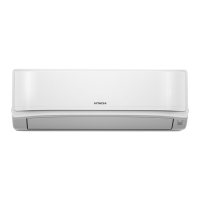
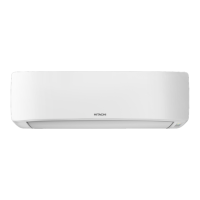

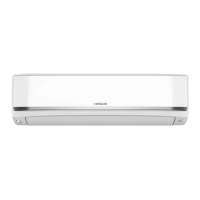




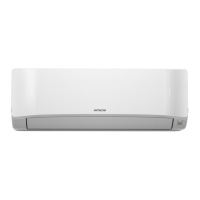

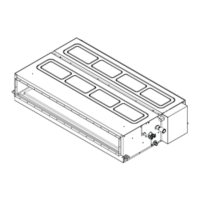
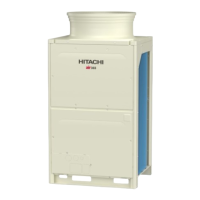

